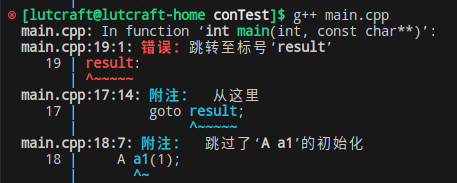构造函数
与类名完全相同的成员函数为这个类的构造函数,构造函数没有返回值.
class A
{
int i;
A();
}
A::A(int i)
{
this.i = i;
};
析构函数
析构函数的命名为在构造函数名前加~,注意析构函数不能有参数.
class A
{
int i;
A();
~A();
};
A::A(int i)
{
this.i = i;
};
A::~A()
{
}
何时构造和析构
在对象创建时创建调用构造函数,在对象的作用域终结时,析构.
举例:
int main()
{
{
A a; //构造
a.i = 1;
} //析构
} //注意:不是在这里析构的!
构造和析构必须成对出现,如果通过goto跳过构造,则编译器会返回error.
class A
{
int a;
public:
A(int i);
};
A::A(int i)
{
a = i;
}
int main(int argc, char const *argv[])
{
int i = 0;
if(i < 10)
goto result;
A a1(1);
result:
return 0;
}
编译这段代码:

含有继承的父子类构造
- 构造子类对象时,会调用父类对象的构造方法,如果子类没有指定,则会尝试调用父类的默认构造方法。
- 在析构子类对象时,会先析构子类,再析构父类。
- name hiding问题,详见:父类子类
样例
#include <iostream>
using namespace std;
class Father
{
private:
int f;
public:
Father();
Father(int);
~Father();
void printSelf();
void printSelf(int);
void setSelf(int a);
};
Father::Father(int af):f(af)
{
cout << "Father constructed! int" << endl;
}
Father::Father()
{
cout << "Father constructed! no para" << endl;
}
Father::~Father()
{
cout << "Father deconstructed!" << endl;
}
void Father::setSelf(int a)
{
this->f = a;
}
void Father::printSelf(int a)
{
cout << "Father f=" << this->f << " a=" << a << endl;
}
void Father::printSelf()
{
cout << "Father f=" << this->f << endl;
}
class Son:public Father
{
private:
int s;
public:
Son();
~Son();
void printSelf();
};
Son::Son()
{
cout << "Son constructed! no para" << endl;
}
Son::~Son()
{
cout << "Son deconstructed!" << endl;
}
void Son::printSelf()
{
cout << "Son s=" << this->s << endl;
}
int main(int argc, char const *argv[])
{
// Father f1(1);
// f1.printSelf();
Son s1;
s1.setSelf(10);
s1.printSelf();
s1.Father::printSelf(2);
return 0;
}
文档信息
- 本文作者:Iven Li
- 本文链接:https://lutcraft.github.io/2023/07/28/C++%E5%9F%BA%E7%A1%80-%E6%9E%84%E9%80%A0%E5%92%8C%E6%9E%90%E6%9E%84/
- 版权声明:自由转载-非商用-非衍生-保持署名(创意共享3.0许可证)